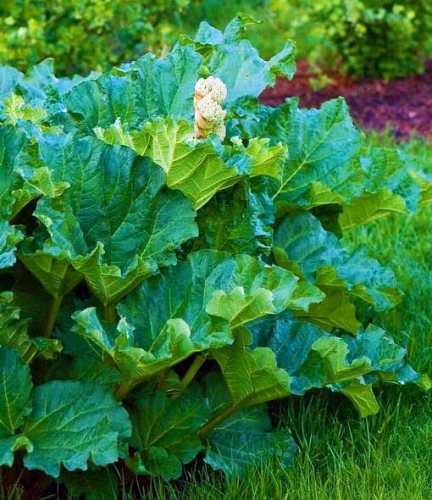Renewing old rhubarb plants
Divide and conquer when renewing your rhubarb for next spring.
For many vegetable gardeners, rhubarb has always been one perennial plant that required virtually no care, but gave back generously. In the spring and early summer, pies and cobblers mixed with apples or strawberries appeared on many dinner tables and were the star attraction.
Right now, many people are living with rhubarb plants that are old enough they could have voted for Eisenhower. These usually robust plants are beginning to decline. If rhubarb is still part of your home-grown taste treats, your plants can be revived to brighten desserts another day. Plan your rhubarb revival meeting for next spring.

Garden rhubarb. Photo credit: Bonsak Hammeraas, Bioforsk - Norwegian Institute for Agricultural
and Environmental Research, Bugwood.org
To renew your rhubarb, it will be necessary to divide the root. The root has become too old and tough to grow well. The time to divide the root will be as early in the spring as you can dig it up. Dig up the root, going about 6 inches deep. Try not to cut into the root at this time. Old roots can resemble a gnarled chunk of wood and are almost as dense. Lift the root out of the ground. Split the root into pieces with at least one bud in each piece. The more buds that are left on the root, the bigger the divided plant will be. You will be dividing your root with a sharp knife, hatchet or axe. You need a big tool for this tough job. Pull away any of the brown stems left from last year’s growing season. If you have several small chunks of root with only one bud on them, when replanting, put all the little parts in one hole together.
Your new divisions should be replanted immediately. The more they dry out, the worse the prognosis for the new plants. If this isn’t possible, put the pieces in a plastic bag and store in the refrigerator for a short time. Before replanting the refrigerated rhubarb, soak the root divisions in room temperature water for several hours or overnight. When planting the roots, cover the top of the root with no more than 1 or 2 inches of soil.
Rhubarb will grow in most soils, but will do best in fertile, well-drained soils that have a good amount of organic matter. Sandy or clay soils can be improved with compost by digging a wide hole and mixing the soil half-and-half with compost. The soil pH should be around 6.5, which is slightly acidic. Choose an area for the rhubarb that has full sun so the plants will produce well. After planting, water the plants well and mulch with 3 inches of straw.
In future years, you can help your rhubarb early in the spring. Rake the straw mulch away from the plant and put down 2 or 3 inches of composted manure around the plant in a ring. Do not cover the crown where the leaves will emerge. Then add the straw to the top. As the manure breaks down during the season, add straw for that magic three inches. Water plants when dry.
Be sure to cut off the seed stalk soon after it emerges from the center of the plant. It will be a long, vertical stalk with a round ball at the top. If the rhubarb makes seeds, it shuts down for the season. But remember, the stalks are edible but the leaves and other parts are poisonous. So just enjoy those tasty stems.



 Print
Print Email
Email